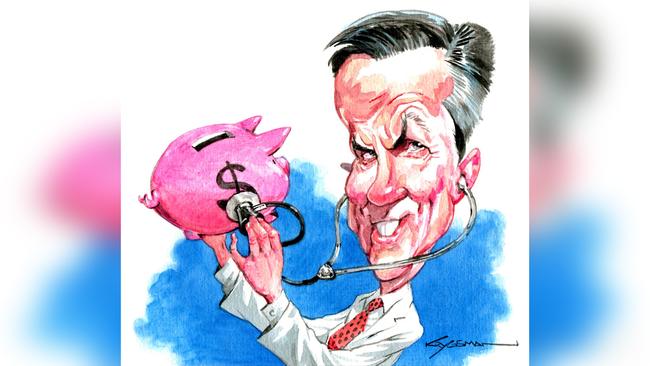
Last month the industry was told to try again when it presented requests to increase premiums by 4 to 6 per cent; the average over the past three years is 2.8 per cent.
Something closer to the latter can be expected when the final decision is handed down later this month or early next month, with the changes to come into effect in April.
Given the political focus on cost of living and the tight government controls over the sector, the decision will be closely watched.
Thanks to better investment returns, industry profits doubled to $2.23bn last year.
Gross margins as a percentage of premiums have also increased for a sector which has seen revenues increase by 11.5 per cent over the past four years, while benefits increased by 7.2 per cent, expenses by 32 per cent and net assets by 19.6 per cent.
Australian households are paying an extra 13 per cent for electricity, and on APRA figures, 25.2 per cent more in home insurance and 18 per cent in car insurance, which puts the highly regulated health sector in context.
A focus on premiums hides the reforms needed, which could help reduce costs – like the $38bn spent on people with chronic health conditions.
Just 1.5 per cent of the national health budget is spent on prevention such as reducing smoking, obesity and other problems.
Australia also remains one of the slowest adopters in the OECD of new care settings that offer more patient choice, minimise unnecessary time in hospital and reduce out-of-pocket costs.
Almost half of all Australian adults have health conditions that could be better supported, with close to 90 per cent having potentially avoidable risk factors, including being overweight, smoking and being physically inactive. Arguably 40 per cent of the disease burden is avoidable with more focus on prevention.
The annual circus of government approval of health premiums – funds lodge big claim increases, government says no, funds come back with the real figure – hides the need to devote more to long term reform.
According to APRA figures private health insurance management expense ratios rate well at 10.8 per cent, against 22.6 per cent for general insurance.
Insurance costs may be high on the list of consumer complaints but economists note people are still reluctant to drop policies to save money. The payback for private health ranks well at 86c in the dollar paid in premiums, against 78c for motor and 77c for home insurance.
Fifty-five per cent of the population now has private health insurance as confidence in public hospitals falls and government rebates and regulations help force the trend.
The industry paid back $4.3bn in unused premiums during the pandemic as fewer people had operations and other procedures but these numbers are returning to more normal levels.
When Butler outlines the health premium increases, the question will be what money-saving productivity reforms he is planning.
Paying the price
Early next month former ACCC and Prices Justification Tribunal chief Alan Fels will hand the ACTU his report on price gouging which can be expected to back calls for increased regulation.
Fels is circumspect on the outcome of his report, which follows a six-month inquiry, nationwide hearings and more than 1000 primarily consumer-led submissions.
His evidence-based report will be critical of supermarkets and support increased powers for the ACCC.
Business lobby groups have already written off the report as politically driven.
The ACTU wants to make it clear wage growth is not the cause of cost of living increases.
On NAB figures inflation this year will fall from 6.8 to 4.2 per cent and GDP growth from 2.3 to 1.4 per cent, which shows the macro environment will be tough heading into next year’s election.
Grocery shake-up
This week’s move by Coles to replace former Victorian premier Jeff Kennett as the arbiter for disputes with suppliers with former Clayton Utz lawyer Jenny Linsten was smart, given Kennett’s poisonous relationship with Grocery Code arbiter Chris Leptos. After 10 years on the tools Kennett is also long past his use-by date.
Following a review by Treasury of part five of the code in September last year, the government on January 10 this year (six months later) agreed to its recommendations to bolster the code.
The changes mean the code arbiter (Leptos) will have the statutory power to demand documentation from the store arbiters like Linsten.
The government also accepted the recommendation that informal approaches can be made to the store arbiters and they can also act as mediators to a dispute.
Kennett insisted on receiving only formal complaints from suppliers and on occasion refused to pass on documentation. The changes will be included in legislation but not until after Craig Emerson finishes his review mid-year.
Last week’s column noted the grocery code governs relations between supermarkets and suppliers, with no direct impact on prices.
When Leptos meets the other code reviewer, Emerson, shortly he will no doubt warn that any strengthening of the power of suppliers can translate into higher prices.
Case in point is the dispute between France’s Carrefour and Pepsi, where the latter’s products have been taken off the shelves after price hikes of 19 and 14 per cent over the past two years.
The public messaging in Australia has been all about evil supermarkets, a political campaign the ACCC happily supported this week, but as noted last week the facts are a little more nuanced, and factors outside supermarket control like climate change and export prices play a big part in consumer price rises for fruit and vegetables.
Many of the long-life products on the shelves like detergents come from concentrated multinational giants.
Still, there is no denying supermarket margins have increased from 4.7 per cent in 2019 at Woolworths to 6 per cent last year and from 3.8 to 4.8 per cent at Coles.
Coles and Woolworths are not exactly saints but the ACCC, the supposed independent regulator, plays a dangerous game by kicking the supermarket can.
Shareholder rights
The Takeovers Panel moved this week towards restricting shareholder intervention in disputes by requiring any complainant to first explain how they have been affected in order to gain standing.
Some argue the panel should arbitrate only on participant disputes with no standing for shareholders.
As the government looks at the Australian Law Reform Commission report on the corporations law, there is merit in suggestions by Herbert Smiths Freehill partner Rodd Levy. He argues one “solution (to corporations law complexity) might be to restate the entirety of chapter 6 (and related provisions) in a single ASIC class order. It would then be a single standalone version of the law. That would be convenient for anyone searching for the relevant rule and would reduce compliance costs, not to mention errors that may occur when people do not locate the correct rule.”








Health Minister Mark Butler is poised to hand down his decision on premium increases for private health insurers at a time when the industry is also in desperate need of potentially cost-saving reforms.